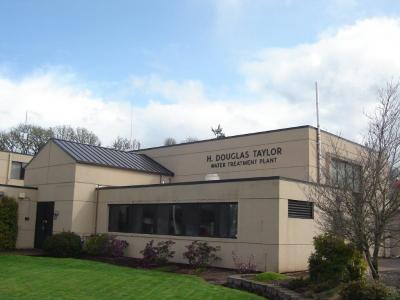Drinking Water Treatment Facilities
The City of Corvallis owns and operates two water treatment facilities. Both the Rock Creek and the Taylor Water Treatment Plants use a four-step process to produce high-quality drinking water. Water treatment is necessary because in nature, water is not always clean enough for humans to consume. During 2020, the two treatment plants produced 2.45 billion gallons of water.
The H.D. Taylor Water Treatment Plant
The Taylor Water Treatment Plant, located in southeast Corvallis, draws water from the Willamette River and produces the majority of Corvallis's drinking water. This plant produced 79% of the City's water supply in 2020; the Taylor Plant's production varies between 3 to 21 million gallons a day, depending on the time of year and customer demand. The Taylor plant was upgraded and expanded in 1997 to bring treatment processes up to date and to provide capacity to supply a growing community. In 2008, additional upgrades increased the effectiveness of the filters to remove contaminants.
Tour the Treatment Plant
To arrange a tour of the Taylor Water Treatment Plant, call 541-766-6932.
Taylor Water Treatment Plant has undergone considerable changes and upgrades during its 60 year history. In 1949, the Taylor WTP was built on the west bank of the Willamette River at what was then the outskirts of Corvallis. The Taylor Plant was built to augment the Rock Creek supply during periods of high demand. Prior to Taylor's construction, the Rock Creek Watershed was the sole supply of water to the city.
The plant was originally designed to treat up to 4 million gallons of water a day. At the time of construction, the population of Corvallis was about 15,000 people. In 1960, as Corvallis' population reached 20,000, the plant's capacity was increased to 8 million gallons a day. By 1970, the town's population had grown to 35,000 and another plant expansion was needed. The expansion in 1970 increased the plant's capacity to 14 million gallons a day by modifying existing structures. Another upgrade was completed in 1981 that primarily focused on updating and modernizing control systems and equipment.
In the early 1990s, as the Corvallis population passed 45,000, growing residential and industrial demand, stricter state and federal regulations, and consumer expectations for taste and odor control were taxing the plant facilities. Around-the-clock operation of the treatment plant was required during high-demand summer periods and improvements were needed to expand the plant's capacity and upgrade processes. This was accomplished with the facility expansion in 1997 increasing capacity to 21 million gallons per day. During the 1997 upgrade, half of the filters were switched from using anthracite as a source of carbon to granular activated carbon (GAC) because GAC provides greater adsorption of organic contaminants. In 2008, the remaining filters were upgraded and also switched to GAC.
Other improvements to the treatment process provide high-quality water to our customers and ensure that new water quality regulations will be met.
The Public Works Department urges all customers to use water wisely to help assure an adequate supply of clean water for the future.
The Rock Creek Treatment Plant
The Rock Creek Water Treatment Plant (WTP) takes water from the Rock Creek watershed on the east side of Marys Peak.
The City of Corvallis began using the Marys Peak watershed for its municipal water supply in 1906. At that time, water was collected and disinfected then flowed through redwood pipes the 16 miles into town. Numerous users along the transmission line, including the City of Philomath, tapped into the pipe to get water. Prior to 1906, Corvallis used the Willamette River as its municipal source of water.
The Rock Creek WTP was built in 1955 and at the time had a design capacity of 4.5 million gallons per day (mgd). Surface water is now collected from three intake points – North Fork Reservoir, South Fork Rock Creek, and Griffith Creek. All three creeks are tributaries to the Marys River. The raw water flows through a system of pipes to the water treatment plant located at the lower end of the Rock Creek watershed. In 1959, an earthen dam reservoir with a capacity of 100 million gallons was constructed on North Fork Rock Creek.
The plant is a conventional rapid sand filtration facility that treats approximately 3.0 million gallons per day. The treated water flows by gravity through a series of 16- and 20-inch diameter transmission lines to the City’s Bald Hill Reservoir. The Rock Creek WTP was upgraded in the early 1980s and now has a capacity of 7 mgd, however, the hydraulic capacity of the transmission pipelines to town is currently limited to approximately 3.5 mgd because of the head pressure generated by the distribution system in town.
In 1986, the City of Philomath constructed its own water treatment facility using the Marys River as its source. At that time, Philomath discontinued using water from the Corvallis municipal water system and the intertie valve was inactivated until 2006 when both cities signed an agreement where Philomath could use the Corvallis water supply when the Philomath water system could not meet their customer demand. The intertie has been used a few times since reactivation.
The Rock Creek Municipal Watershed is approximately 10,000 acres and is jointly owned by the City of Corvallis and U.S. Forest Service. The City owns approximately 2,500 acres.
